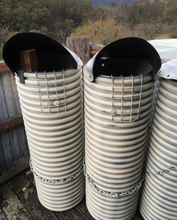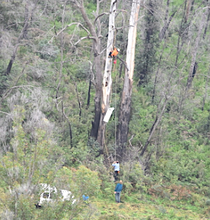Gift towards Cockatube's for Endangered Glossy Cockatoo. for nesting at Rocklily.
We can email a printable PDF you can give as a gift, or enclose this in one of our photo cards and post please ask! This is only part of the cost for 1 box.
With almost no hollow nest sites in the burnt out landscape here Rocklily has started a project of building and installing nest box’s to replace burnt tree hollows, as most large old trees completely burnt. For remaining birds and various mammals and as well planting appropriate trees and shrubs.
The small group of 12 Glossy Cockatoos we have had nesting therefor many years have lost their group of old nesting trees. They will not nest in built nest box's and we have found a landcare group in WA whom has designed and having success with these cockatubes. (talk to us for more details) (most tail feathers have a black stripe the red with some yellow but not all )
- 5 x Glossy, red tail, and yellowtail ,Cockatube tubes x 5 at $460 ea plus freight $2,900 (seem to have the absolute best take up of Glossy cockatoos of all nest boxes and we have 3 glossy left.
Cockatubes have been installed at 10 metres up some trees very close to those they nested in. We have pained ours to match the trees, which also reduces the ambient temperature in them from. black or dark tube by 18 degrees in summer. They are placed facing SE and have small hats to help prevent snow building up in them.
There is. alarge group of casuarina trees unburnt about 4 km away and more within 8 km, so plenty of food still.
Information FROM BACKYARD BUDDIES
The Glossy Black-Cockatoo is the smallest black-cockatoo in Australia. They are entirely black, but if you look skyward and glimpse a streak of red on a jet black tail, you’ve probably just found one.
Glossy Black-Cockatoos are about 46-50 cm long. Males have brownish heads and chests, with red tail feathers. Females have yellow patches on their heads and necks, with orange-red barred tail panels. Both have small crests with a broad and bulbous bill for cracking open tasty cones. They are often confused with their close relative, the Red-tailed Black-Cockatoo who are also glossy and black with red tails.
Where are they found?
The Glossy Black-Cockatoo is widespread across eastern Australia. There is also a small cluster found on Kangaroo Island, South Australia.
Glossy Blacks are found mostly in three Australian regions: south-eastern Queensland, eastern Victoria, and on Kangaroo Island in South Australia. They are drawn to woodland and open forests with casuarina trees. A pair of Glossy Blacks eats about 60-89 thousand casuarina cones a year, however bushfires and habitat clearing can make this a difficult target. As a result the Glossy Black-Cockatoo is now a protected species in NSW.
Fast facts:
- These close-knit cockatoos live in very small groups, with usually two to three members. Their call is soft and gentle, and they repeat the sound ‘tarr-ed‘ to communicate with each other. This can help to tell them apart from their Red-tailed cousins, who talk in a sharper ‘kree‘ sound.
- OUR CONSERVATION STATUS
National: Endangered
Were just a couple of ordinary folk who are trying to do the right thing. We fund all our wildlife work from our online shop and get no government or other funding. We are not a charity




